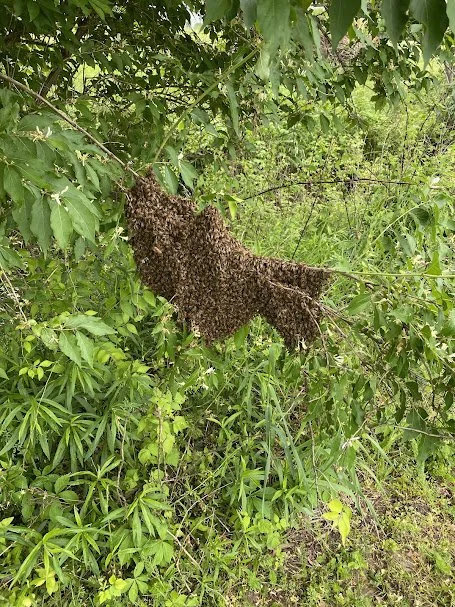Catching Swarms
Swarm season is an annual event, usually beginning in late April/early May, and lasting about 3 weeks. It tends to coincide with the spring honey flow. This year, due to colder temperatures and record rainfall, we didn’t start seeing swarms until mid-May. Swarming is a natural activity for the bees and a sign of a strong colony. Bees will swarm for a number of different reasons.
One reason is that the hive is getting too crowded. This type of swarm is usually found later in the season, sometimes in summer. Bees collecting outside a hive in an activity called “bearding” (because it literally looks like a beard of bees hanging from the front of the hive) could be because it is too hot inside the hive, or it could be a sign that the hive is too full and may swarm. Another reason is that a queen has begun to be less productive. Sensing this, the worker bees will create new queen cells to raise up a new queen. Since a hive can only have one queen, the current one will take about half the worker bees and some drones and leave the hive to find a new home.
The first indication that a swarm is forming is when there are many small groups of bees flying around in the bee yard. This activity is different than the normal flights that take place each day, and it means that the bees are trying to figure out where to go. This can last around 15-20 minutes until they decide were they will hang out, which usually on a tree branch. Once they decide on a branch, the bees—which can number up to 10,000-20,000—will form a ball around the queen. They will hang on this branch until one of the scout bees returns to let them know where their new home will be. Sometimes this will take a day or more. If the beekeeper is lucky, they will discover the bees during this time and catch them before they all fly off to their new home.
To catch a swarm, the beekeeper will place a bin under it and shake the bees into the bin. The best scenario would be a swarm on a low-hanging branch that is easily accessible. The more common and less desirable situation is when a swarm is higher up in a tree. Depending on the location of a swarm, the beekeeper will need to use a ladder to reach them. After shaking the bees into the bin, the beekeeper will pour the bees into a new hive. Not all bees will go directly into the hive. Sometimes they might mill about for a while. If the queen goes in, the rest will follow. You know you are successful if you see bees on top of the new hive with their butts facing out and their wings lifted and fluttering. This means they are fanning their pheromones to signal to the other bees that this is their new home. You should see eggs in the hive within a few days. They will immediately begin to draw out comb if they need to. We have a good supply of drawn comb on hand to give them a head start. If the swarm took a new queen with them instead of their current queen, she will need to go on a breeding flight. We will discuss more about this interesting mating ritual in a later post.
There can be different dynamics to a swarm, and not all swarms behave the same. In general, a swarm is rather docile and you don’t need to fear them. They don’t have a hive to protect and will not be aggressive. If you see a swarm on a tree, they are in transit and will probably only be there temporarily. If you are concerned, visit the website of a local bee club. They usually have a list of beekeepers who will capture and re-home your swarm. Never try to catch a swarm on your own.
Bee swarms are a beautiful and amazing part of the lifecycle of bees. To see a swarm in person is a rare and wonderful opportunity. It is a complex and highly orchestrated way for a colony to expand and remain strong, and one that has taken place over millions of years.
